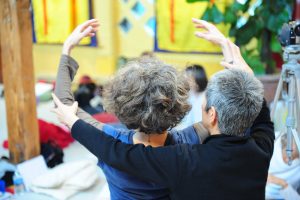
Photo credit: Beth Lutz. Used with permission.
“Touch is the other side of movement. Movement is the other side of touch. They are the shadow of each other” – Bonnie Bainbridge Cohen
[Editor’s note. Touch and movement are keystones of the Body-Mind Centering® Approach. They are the earliest senses to appear and help set the foundation for the development of the other senses and for our perception and awareness. Touch and movement are doorways into the exploration of consciousness.
Here are some of Bonnie’s thoughts about this important part of somatic movement education. What she describes here is ideal development. Not everyone has an ideal birth or an easy prenatal or perinatal experience. However, even as adults, our systems still have some plasticity so that, even if our early development was difficult, we still have the potential to access these innate processes and to discover the full powerful and nurturing support of movement and touch.
Many of Bonnie’s ideas here have been shaped by fifty years of working with infants, children and adults. For those of you who are new to her work or thinking, I refer you to her book, Sensing, Feeling, and Action. Some of the chapters cover different aspects of developmental movement as well as other important aspects of the Body-Mind Centering® Approach.]
Touch and Movement
by Bonnie Bainbridge Cohen
Our senses begin as potential. They develop in response to experience.
The primary sense organs of touch and movement are located throughout the body — in every cell. Touch is emphasized in the skin. Movement is emphasized in the proprioceptive and kinesthetic receptors in the joints, ligaments muscles and tendons, the interoceptors of the organs, and the vestibular mechanism of the inner ear. Movement and touch develop simultaneously. Touch is the other side of movement. Movement is the other side of touch. They are the shadow of each other.
We first experience these senses in utero. As we move in utero, our skin is stimulated by the amniotic fluid, the uterine wall and by one part of our body touching another. Thus we discover touch and movement in synchrony. Movement occurs at two levels, movement of our cells within the boundaries of the skin and movement of the body through space. Touch also occurs at two levels, cellularly and contact of our skin from the outside.
The experiences of movement and touch in utero are primary factors in establishing our ability to comprehend and organize touch and movement after birth — to receive from outside and to express ourselves from within. These experiences also allow us to actively differentiate between what is occurring within the boundaries of our skin and what is occurring on the outside of our skin — to know who we are and who we are not.
When we are in utero and our mothers move, and we move as one, there is no stimulation to our skin. What occurs within, occurs without. Outside and inside are united. These experiences of motion with constancy of touch are primary factors in establishing our ability to join with and feel one with forces originating outside ourselves. The development of this sense is reflected in the movement profile of our mothers during pregnancy.
The experience of touch without movement occurs in utero by the movement of our mother’s organs and stroking and changes of pressure upon her belly. These experiences are important in establishing a baseline for accepting physical contact.
During birth, the dialogue between movement and touch continues. We experience moving through space as our mother moves. The contracting uterus provides outer stimulation. As we move, the uterine wall gives us feedback about how and where we are moving. Our mother feels our movement as inner touch. We pay attention and we respond. We dance our birthing!
Emerging, we are caught and embraced. We fly through space and each of us snuggles into our mother’s arms and nurses. Movement and touch nurture us from within and without.